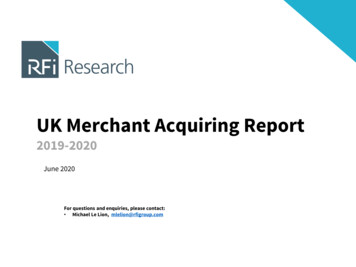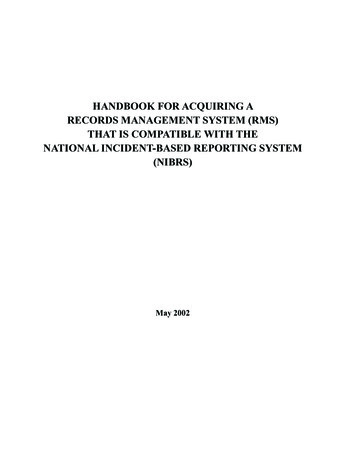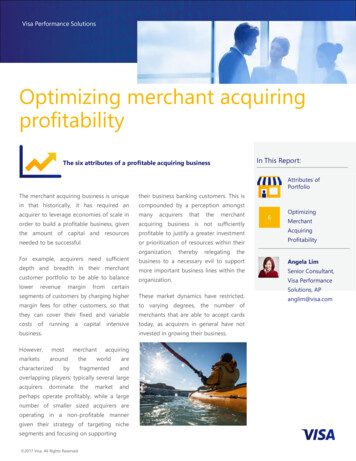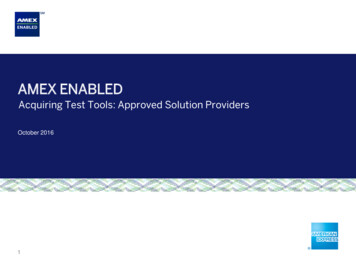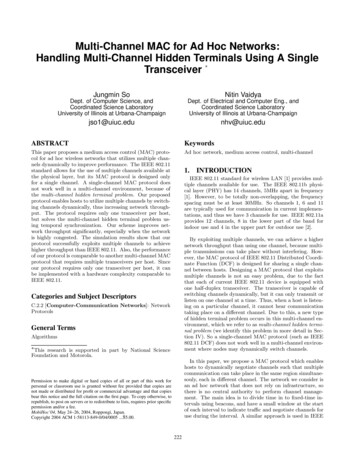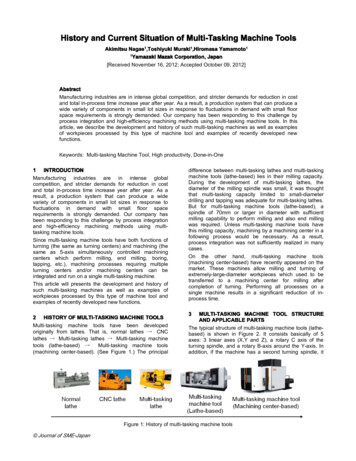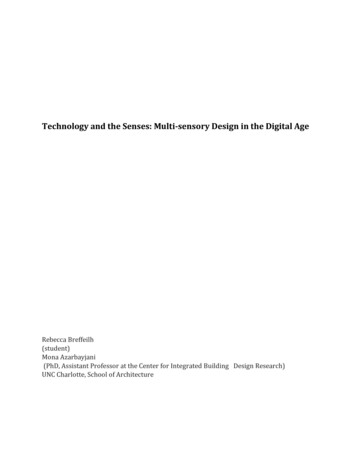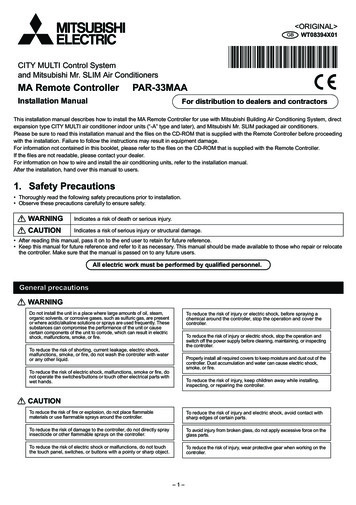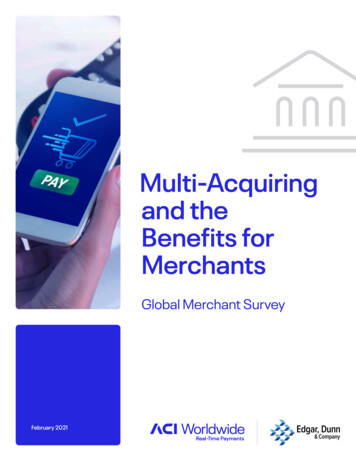
Transcription
Multi-Acquiringand theBenefits forMerchantsGlobal Merchant SurveyFebruary 2021
Contents1. Executive Summary . 32. Merchant Survey Findings . 52.1 Background of Merchant Survey and Participants . 52.2 Merchants Working with Multiple Acquirers . 62.3 Merchants Working with a Single Acquirer . 133. Conclusion . 164. Survey Methodology . 175. Merchant Survey Dashboard . 182
1Executive SummaryACI Worldwide, in partnership with Edgar, Dunn & Company (EDC), hasundertaken a study to explore the acquiring strategies adopted by leading globalmerchants and PSPs to determine the operational financial and other benefitsassociated with different approaches. This report includes the research findingsfor merchants and their acquiring relationships, whether they are direct or via apayments gateway.EDC surveyed merchants from across the globe in the final quarter of 2020.Insights derived from the survey were supported by in-depth interviews withselected merchants.The study reveals that merchants operating across different vertical segmentsidentify three main advantages of an acquirer independent strategy and use ofan acquirer-agnostic payments gateway that can support multiple acquirers. Insummary the advantages are:Resilience – Merchants can maintain business continuity in the event that anacquirer experiences a service outage or a business failure. Having multipleconnections to acquirers reduces the risk of being unable to authorizetransactions, as these can be re-routed to an alternative acquirer.Offering a range of alternative payment methods (APMs) – Merchants canincrease the range of APMs accepted at checkout by using connections tomultiple acquirers to better serve customers in different verticals or geographies.Increased sales – Merchants can route authorization transactions to differentacquirers to maximize payments acceptance. By optimizing transactionrouting to multiple acquirers, a merchant can reduce declined transactions, soincreasing sales revenues.The significance of each advantage identified by our merchant sample variesdepending on size of the merchant, vertical segment in which they operate andsales channels. This report aims not only to capture the total overview of themarket, but also to determine how the nuances in size and category can affectthe importance a merchant places on a payments gateway that is acquireragnostic. We hope that this will enable merchants to determine the expectedbenefits specific to their business before changing the number of their acquirerconnections.3
Summary of Key Survey Findings The top three reasons why merchants work with more than one acquirer are:resilience (21%), reduced operational costs (18%) and improved conversionrates (14%) 85% of merchants that have moved to multiple acquirer relationships haveseen an increase in conversion rates, with 23% of respondents increasingtheir conversion rate by more than 10% 71% of merchants that use a multi-acquiring strategy are either satisfied orvery satisfied 40% of merchant respondents that use a single acquirer wish to swap toa multiple acquiring arrangement in the next 12 months. Reasons giveninclude the desire to gain flexibility and access to APMs (17%), to reduceoperational costs (17%) and to build resilience in their acquiring options (15%) It is mainly smaller merchants who have a single acquiring relationship (30%),with the main rationale being cost efficiency or commercial reasons (60%)4
2Merchant SurveyFindings2.1 Background of Merchant Survey andParticipantsThe aim of the survey was to determine the rationale for different acquiringstrategies adopted by merchants and to explore the operational benefitsexperienced by merchants who work with a payments gateway that is able tosupport multiple acquirers. To get the full picture of the market, we used a variedsample of merchant respondents, including merchants of different sizes, fromdifferent verticals and from around the globe (see section 5 for merchant surveydashboard). We investigated the number of acquirers a merchant works with andwhy they choose to operate this way. In total, 93 merchants were surveyed, withthe majority of merchants operating in North America, Europe/MEA or globally.How many merchant acquirers do you currentlywork with across your entire business?12-56-10 1043%44%5%8%Figure 1Note: Throughout this report, percentages have been rounded for simplicity, with the result that charts andgraphs may not always total to 100%.43% of merchants in our survey work with just a single acquirer, while 57%have a multi-acquiring arrangement. The number of acquirers worked withby merchants with multiple relationships varies: 44% of merchants work withbetween two to five acquirers while 8% are using more than 10 acquirers (withthree merchants using between 30 and 33 acquirers and one merchant using57). Multiple acquiring arrangements are becoming more popular. 57% ofmerchants use multiple acquirers today and another 40% of respondents thatcurrently use a single acquirer wish to swap to a multi-acquiring arrangement inthe next 12 months.5
Do you have plans to change your acquiringarrangements within the next 12 months?YESWe wish to havemore than onemerchant acquirerNO34%40%YESWe wish to swapour single merchantacquirer arrangementto an alternativemerchant acquirerYES11%15%We wish to swapfrom multipleacquirers to a singlemerchant acquirerarrangementFigure 22.2 Merchants Working with Multiple AcquirersThe following section will examine how satisfied merchants are with usingmultiple acquirers, and explore their primary reasons for opting for such anarrangement. We explore how these reasons vary based on merchant size, aswell as consider the major benefits seen by merchants swapping to a multiacquiring arrangement.If you work with multiple acquirers, how wouldyou rate your satisfaction with your isfied24%VerySatisfied15%Figure 3Of the 57% of merchants that stated they use a multi-acquiring arrangement(Figure 1), the majority are either satisfied (47%) or very satisfied (24%). Only 6%of merchants are dissatisfied, with one of the reasons given being that legacybanking acquiring platforms are outdated and provide poor reporting capabilities.The number of merchants that are neutral or dissatisfied derives from the 15% ofmerchants that wish to change from a multiple acquiring arrangement to a singlearrangement, as seen in Figure 2 above.6
Which of the following descriptions best matchesthe rationale for your plans to change yourmerchant acquiring arrangements within the next12 months? (Select up to 3 options)Proportion of Respondents (%)30%25%20%15%10%5%15%0%17%15%5%12%17%5%Yes –We wish to have more than onemerchant acquirerBuild resilience in your acquiring optionsReduce costs27%13%7%13%27%Yes – We wish to swapfrom multiple acquirers toa single merchant acquirerarrangementIncrease your revenues by improvingyour conversion rateGain access to more AlternativePayment Methods (APMs)Increase your revenues by improvingyour cross-border reachIncrease your revenues by reducing thetransaction decline rate“Merchants want to beable to accept a widerange of paymentmethods, or even allowtheir customers to payover a few monthlyinstallments. Therefore,we need to be gatewayand acquirer-agnostic sothat we can provide theright solution to fit themerchant’s needs andwe don’t fit the merchantto the solution.”Nick FoxManaging DirectorAccess Merchant ServicesOtherFigure 4Figure 4 displays the reasons why certain merchants are planning to change theirexisting acquiring arrangements within the next 12 months. Reducing costs andincreasing the range of alternative payment methods (APMs) accepted are themain reasons for merchants to reduce the number of acquirers they are workingwith to a single acquirer arrangement.Merchants who are planning on working with a single acquirer to reduce costsare likely to extend the relationship with a cheaper acquirer to cover all theirpayment needs. We can only hypothesize that the reason some merchants wantto work with a single acquirer to gain access to more APMs is linked to the factthat merchants are dissatisfied with their acquirers and their legacy bankingplatforms which are outdated. These legacy platforms are unlikely to support awide range of APMs, pushing merchants to terminate these outdated acquiringrelationships, and opt for a single acquirer that can support a wide range of APMs.“Our philosophy when it comes to payment types is thatwe must accept all the different types of plastic cards andas many alternative payment methods as possible. Wecurrently accept 35 alternative payment methods aroundthe world. We are always thinking about adding more to thislist, such as open invoice, bank transfers, etc.”ACI InsightAccess to relevant APMsis critical for merchantsas they seek to expandtheir businesses, whetherdomestically to attracta more diverse range ofconsumers or internationally,into new markets. It is alsoessential to be able tosupport customers withflexible payment optionsas their circumstances andneeds change. Through2020, we saw a significantincrease in demand for“pay later” and “pay byinstallment” options asthe COVID pandemic hitthe financial security ofconsumers around the world.Payment Director, Global Fashion Retailer7
Improved access to APMs is also, perhaps more understandably, a driver formerchants wishing to multiply their acquiring relationships—with another keyreason being the need to build greater resilience. The increasing transactiontraffic to which these acquiring platforms are exposed can often put too muchstrain on them, leading to periods of outage which may, in turn, lead to failedtransaction conversion.Overall, the primary reasons given by merchants for working with multipleacquirers (Figure 5) are resilience (21%), reducing operational costs (18%),improving conversion rates (14%), enabling cross-border eCommerce (11%)and enabling acceptance of a wider range of alternative payment methods(11%). Other arguments the respondents have provided include: operatingacross multiple geographies—which requires them to have different acquirersfor different markets, ensuring compliance because of Britain’s exit fromthe European Union, leveraging pricing advantages from local acquirers andsupporting domestic payment schemes.What are your primary reasons for working withdifferent merchant acquirers? (Select up to3 options)Proportion of Respondents (%)25%20%15%10%2118115%1114116620%ResilienceAccept a wider range of APMsReduce operational costsReduce declined transactionsEnable cross-border eCommerceDistribute risk among merchant acquirersOtherDistribute chargebacks amongmerchant acquirersImprove conversion rateFigure 58
If we examine the primary reasons given for a multi-acquiring arrangementthrough a different lens, we can observe (Figure 6) that they vary depending onmerchant size. If we look at large merchants, the main reasons given for usingmultiple acquirers are resilience, flexibility (enabling acceptance of a wider rangeof APMs) and reducing operational costs.Merchants with revenues between 50M and 200M still find resilienceimportant, however reducing operational costs and improving conversion ratesare considered more critical.Proportion of Respondents (%)What are your primary reasons for working withdifferent merchant acquirers? (Select up to3 options)Merchant Size (based on transaction value)ResilienceEnable cross-border eCommerceReduce operations costsDistribute risk among differentmerchant acquirersReduce declined transactionsDistribute chargebacks amongdifferent merchant acquirersImprove conversion rateAccept a wider range of APMsOtherFigure 69
The size of a merchant is not the only factor which could impact a merchant’sdecision to work with multiple acquirers. Merchants in different industry verticalshave different needs and types of transactions to process, which will affect therequirements for their acquirer relationships. We can observe from Figure 7below the varying reasons why merchants within different verticals work withmultiple acquirers.What are your primary reasons for working withdifferent merchant acquirers? (Select up to3 ketetail0%GenProportion of Respondents (%)100%Merchant Size (based on transaction value)ResilienceEnable cross-border eCommerceReduce operations costsDistribute risk among differentmerchant acquirersReduce declined transactionsDistribute chargebacks amongdifferent merchant acquirersImprove conversion rateAccept a wider range of APMsOtherFigure 7Improving resilience is a constant among the reasons why merchants acrossverticals choose to work with multiple acquirers. The rise of electronic formsof payment and eCommerce makes having backup acquirers more importantin case of difficulties in processing a transaction, regardless of the vertical.Reducing operational costs is also a common reason to choose multipleacquirers, to leverage price differences offered for different payment methodsand geographies. For those merchant verticals which tend to have a highernumber of foreign customers, such as in hospitality (28%), travel (17%), andentertainment (19%), accepting a wide range of APMs is one of the main reasonsfor having multiple acquirers. These merchants want to make sure they canaccept the preferred payment methods of these customers, such as Asian digitalwallets and European domestic schemes.10
Enabling cross-border eCommerce is becoming an increasingly important factorin the decision to adopt multiple acquiring relationships. While eCommerce is“borderless,” merchants will benefit from having tailored relationships to ensurethey can seamlessly accept payments from across a wide geographic scope.Verticals in which enabling cross-border eCommerce is important include digitalcontent and services (23%) and specialty (15%)—including bookshops, shoeshops, florists, sporting goods, and camping and outdoors. The needs of thesemerchants, who want to operate across geographies, enable cross-bordereCommerce and attract foreign customers with alternative payment methods,cannot be effectively satisfied by a single acquirer.Another important factor for different verticals is reducing the rate of declinedtransactions. Merchants in verticals with typically high transaction values needto ensure they maintain a low rate of declined transactions to avoid losing out onpotential sales. Examples include merchants within travel (17%), fuel (17%) andentertainment (13%).Although increasing conversion rates is not given as one of the main reasonswhy merchants swap to a multi-acquiring arrangement, 85% (Figure 8) ofrespondents that moved to multiple acquirer relationships have seen an increasein conversion rates. 43% of respondents have seen an increase of 1%-5%, 19% of6%-10% and a further 23% saw an increase greater than 10% in conversion rates.Do you agree with the following statement, thathaving multiple acquirer relationships can increaseyour conversion rate?23%43%Yes, ourconversionrate increased15%19%No, we saw no changein our conversion rate0%1% - 5%6% - 10% 10%“If you are a merchantthat sells in differentregions, you need tohave multiple acquirerrelationships to optimizeyour acceptance rates.You need a portfolio ofacquirers to serve thespecific needs of themerchant.”Thierry ArrondoRisk & PaymentsVendo Services“We have multipleacquiring relationshipsand nine PSPs across ourglobal operation. Thisis not just because nosingle PSP can cover theworld but because weare carefully monitoringthe conversion ratesand domestic acquiringis required to acceptdomestic paymentschemes, such as CartesBancaires, in France. Thishelps us to reduce thecost of acceptance andimproves the conversionrate.”Payments DirectorGlobal Fashion RetailerFigure 811
While fraud prevention was not a topic explored within our acquiring survey,merchant commentary in subsequent interviews has highlighted thesignificant role played by fraud management capabilities in conversion—andthe need for merchants trading in the U.K. and European Union to manageeffectively their exemption strategy under new PSD2 strong customerauthentication (SCA) requirements.In Europe, we are seeing a number of merchant customers seeking to controltheir own 3D Secure exemption handling within the SCA environment, ratherthan relying solely on their acquirers to do so. Further benefit is likely to bederived from a multi-acquiring strategy here since, where a primary acquireris unable to adhere to transactional risk analysis metrics under PSD2, this mayadd friction to a merchant’s transaction flow through no fault of its own. Theability to switch traffic to an alternative acquirer in such circumstances wouldseem a sensible, even essential, option.In other regions, where PSD2 does not apply, there is clear evidence thatdynamic use of 3D Secure can significantly improve conversion rates.“Using the fraud prevention solution from our PSP allows us to have accessto a wider range of information to be more precise in terms of scoring, toconduct a more detailed analysis and thus to take better decisions whendeciding whether to trigger 3D Secure or not.”Xavier Fouré – E-Commerce Treasury Manager, DecathlonDynamic 3D Secure—Use CaseWith surging demand from online and Click and Collect sales, a large furnituremerchant sought to add an extra layer of security to their U.S. operationswith minimal impact on sales. The merchant implemented ACI s dynamic3D Secure functionality, selecting 18% of transactions for 3D Secureauthentication over the past 12 months while allowing the remaining 82% oftransactions to flow through without 3DS screening. Just 0.53% of screenedACI InsightAcross our customer basewe see a significant increasein conversion rates achievedby merchants adopting amulti-acquiring strategy.A powerful example isone of ACI’s major onlinegaming customers thatswitched from a global toa local acquirer in a keygeographical market.This was achieved using aphased approach, deployingour weighted dispatchingcapabilities. Credit cardtransactions were movedgradually to the local acquirerto ensure the companycould manage the volumesbeing delivered. Oncetraffic was fully migrated,the connection to the globalacquirer was retained toprovide smart retry andalternative acquirer optionsin the market. The resultof this move from a globalacquirer to a local acquirerwas a significant 42%increase in the acceptancerate over an eight-monthperiod.transactions were rejected and the merchant has been able to hold down thechargeback rate while maintaining a 92% overall conversion rate.“Because we operate an omni-channel business we have to be smart athandling our payment transactions. This is especially important for ourEuropean online business where we must be ready for the PSD2 and SCA rulechanges that will be implemented in 2021. Leveraging aggregated fraud datafrom our fraud prevention partners is a significant advantage for our businesswhen making decisions to accept payments.”Payments Director – Global Fashion Retailer12
2.3 Merchants Working with a Single AcquirerThe following section will examine the reasons why merchants opt for a singleacquiring
experienced by merchants who work with a payments gateway that is able to support multiple acquirers. To get the full picture of the market, we used a varied sample of merchant respondents, including merchants of different sizes, from different verticals and from around the globe (see s
